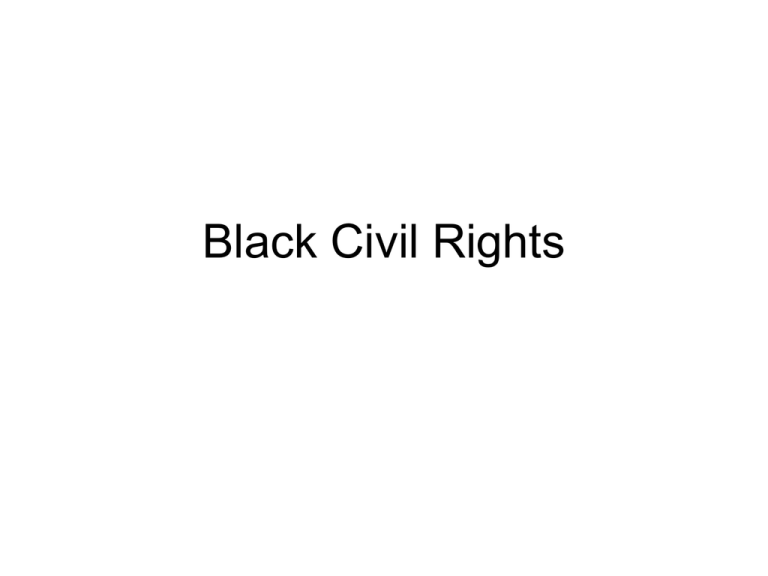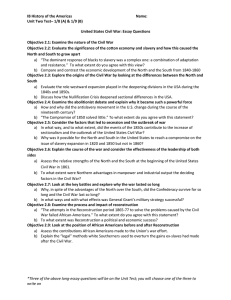Black Civil Rights - New Jersey City University
advertisement

Black Civil Rights Overview • • • • • Early racial relations Leading up to Civil War Civil War and Reconstruction Jim Crow The Modern Civil Rights Movement Early Race Relations • Slavery – In the Constitution • Article I, section 9 (importation of slaves protected until 1808; tax on importation capped at $10) • Article IV, section 2.3 (Fugitive slave law) • No mention made of federal power to end slavery but... Early Race Relations Supreme Court rulings raised concerns among slave states, in particular: McCulloch v. Maryland (1819) Gibbons v. Ogden (1824) Early Race Relations • Article IV, section 3.1 provides new states may be admitted to union • By ratification of the Constitution, every state from Delaware south was a slave state, all north were free* *New Jersey ended slavery in 1804 Missouri Compromise • Issue of maintaining rough balance between free and slave states in Senate, if not in the House • Agree to admit Missouri (slave) and Maine (free), and set aside unorganized land above the 36o30 as free Missouri Compromise Pre-Civil War • Mexican-American war (1846-1848) US acquires vast amounts of new territory • Reintroduces question of balance of free/slave states • How to partition this new territory? Compromise of 1850 Worked out by Henry Clay (Whig-KY) California comes in as free state, and in exchange the land gained in the Mexican War will allow slavery as a local choice. Also strengthened the fugitive slave law Compromise of 1850 Kansas-Nebraska Act • Unorganized territory of the 1850 Compromise is organized as Kansas and Nebraska territories • Act authorized local elections to determine which, if either, territory would become free or slave Kansas-Nebraska Act Scott vs Sanford • At issue is fugitive slave law; that is, are slaves still slaves after they reach a free state? • Dred Scott sues • Supreme Court rules against Scott and invalidates the 1850 Compromise for good measure Civil War Civil War • Emancipation Proclamation (1863) – frees slaves in Confederacy and in those parts of the country in open rebellion – specifically exempts border states and areas currently occupied by Union army • 13th Amendment (1865) – ends slavery Civil War • 1864 Presidential Election • Lincoln runs on “national unity” ticket that includes Andrew Johnson as VP Reconstruction • 2 Phases of Reconstruction – Presidential Reconstruction (1865-1866) • Readmit confederate states • No Confederate officials eligible to serve in government • Confederate states redraw constitutions to take account of 13th amendment – Introduction of “Black Codes” Reconstruction • Republican Congress passes Civil Rights Act (1866) over Johnson veto • House moves to impeach Johnson, Johnson survives, but is much weakened as president • Enter Congressional reconstruction period (1866-1877) Reconstruction • • • • • • Union army occupies south 14th Amendment (1868) 15th Amendment (1870) Civil Rights Enforcement Act (1870) Civil Rights Act (1872) Civil Rights Act (1875) Reconstruction • First black political leaders elected to Congress • Hiram Revels (MS) first black senator • 6 blacks elected to serve in House in 41st and 42nd Congress Reconstruction • 1876 Presidential Election • Rutherford B. Hayes (R) • Samuel Tilden (D) 1876 Presidential Election Reconstruction • In exchange for Hayes winning electoral college vote, Republicans agree to end occupation of the South • 1877 Reconstruction essentially ends with end of occupation • Southern governments and vigilante groups move to disenfranchise black voters Rise of Segregation • Voter intimidation (e.g., KKK activity) • Change voting requirements – poll tax, literacy test, “white” primaries, grandfather clause • Civil Rights cases (1883) – Supreme Court invalidates the 1875 Civil Rights Act • Plessy vs Ferguson (1896) Plessy vs Ferguson Homer Plessy “The object of the [Fourteenth] Amendment was undoubtedly to enforce the absolute equality of the two races before the law, but in the nature of things it could not have been intended to abolish distinctions based upon color, or to enforce social, as distinguished from political, equality, or a commingling of the two races upon terms unsatisfactory to either.” -Justice Henry Billings Brown Plessy v. Ferguson "We consider the underlying fallacy of the plaintiff's argument to consist in the assumption that the enforced separation of the two races stamps the colored race with a badge of inferiority. If this be so, it is not by reason of anything found in the act, but solely because the colored race chooses to put that construction upon it.” Justice Henry Billings Brown Jim Crow Jim Crow Jim Crow statutes by state Jim Crow • For black civil rights leaders, segregation posed difficult questions of strategy and how to combat legal (de jure) inequality Response to Segregation • Booker T. Washington and “Accomodationism” • Take whatever opportunities white America provides and do best you can until conditions change Response to Segregation • W.E.B. Dubois and the founding of the NAACP • Legal strategy of challenging the “separate but equal” provision Separate, but Equal? Classroom in black school Seat Pleasant, Maryland Separate, but Equal? Black school, Camden, MS Separate, but Equal? Black school, Louisa County, VA Response to Segregation • Key desegregation cases: • Missouri ex rel. Gaines v. Canada (1938) – mandated creating separate black law school or admitting blacks to white school • Sweatt v. Painter (1950) – mandated that separate black schools be equal to white law schools Response to Segregation • McLaurin v. Oklahoma State Regents for Higher Education (1950) – integration has to be equal; cannot maintain segregation within a school Response to Segregation • 1954 Brown vs. Board of Education of Topeka, KN Response to Segregation Little Rock, Arkansas September 1957 Federal troops protected 9 black students going to Central High in Little Rock throughout 1957 academic year Response to Segregation Little Rock opted to close all 3 public high schools for 1958 academic year rather than integrate Modern Civil Rights • Emergence of Modern Civil Rights Movement Modern Civil Rights • In wake of Brown v. Board of Education, combination of further legal challenges, political mobilization, civil disobedience (peaceful and other) Modern Civil Rights • Key Legislation: – 1964 Civil Rights Act • • • • Barred discrimination in public accomodations Desegregated public school and facilities Civil Rights Commission expanded Equal Emploment Opportunity Commission – No discrimination in workplace based on race, color, religion, gender, or national origin. Modern Civil Rights • Key Legislation – 1965 Voting Rights Act • Outlawed discrimination in voter registration • Authorizes federal government to administer voter registration in counties or subdivisions held to discriminate on voter registration efforts Lingering Segregation “A Realtor should never be instrumental in introducing into a neighborhood a character of property or occupancy, members of any race or nationality, or any individual whose presence will clearly be detrimental to property values in the neighborhood.” (Association of Real Estate Boards, National Realty Code, Article 34) official policy through the 1960s Fair Housing Act • 1968 Civil Rights Act – No discrimination in housing – No discrimination in mortgage lending – Penalities imposed on anyone interfering with individual civil rights workers Modern Civil Rights • Remedies to past discrimination – Busing – Affirmative Action – “Urban Renewal” Projects Race and Urban Populations Race and Urban Populations Race and Urban Populations • Overall data: – Not just higher percentage of blacks in cities, but economic situation within those cities • 1970: 27% of census tracts in urban areas were “poverty,” and 6% of these were “extreme poverty” • 1990: 39% of census tracts in urban areas were “poverty,” and 14% of these were “extreme poverty” • Improvement in 1990s though – Poverty rate higher than that of suburbs • 2000: 16.1% (urban) • 2005: 13.9% (urban) 7.8% (suburban) 9.6% (suburban) figures from US Bureau of Census Race and Urban Populations • Concentration of blacks in poverty areas – 1980: • 2.0% of all U.S. non-Hispanic white poor people, • 21.1% of all U.S. black poor people • 15.9% of all U.S. Hispanic poor people lived in ghettos. Thus, over two-thirds of the ghetto poor are black and Hispanic. – 1990: 71% of low-income, black, central-city residents lived in poverty neighborhoods • 40% of low-income, white, central city residents – 2006 Poverty Rates by race/ethnic origin – 2006 demographics of poorest of poor Effects • Most children living in high-poverty areas attend racially segregated schools: – 1996: 8% of nation’s school children attended schools with 90% black/latino enrollment • and over 90% were located in central cities – Impact on education? • Recent test score data, graphic data Effects • Employment – Unemployment rates by race – Inner city unemployment • 2 to 3 times higher than national average – Impact of low employment/joblessness How to remedy? • What steps can government take to fix de facto forms of segregation?




